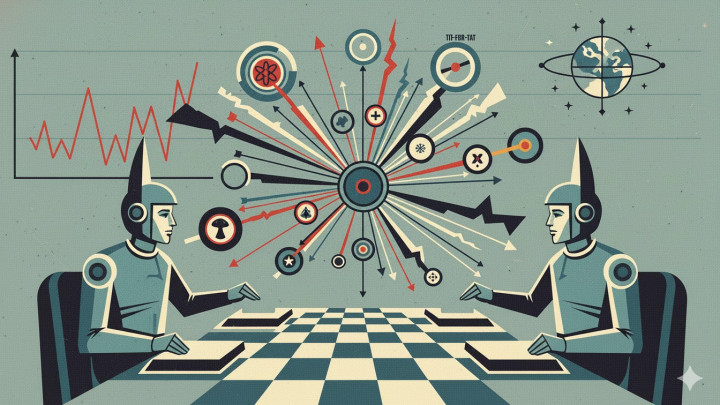Beyond Tit-for-Tat: The Hidden Engines of Human Cooperation
What is the invisible force that binds complex societies together? Why do we help a stranger, trust the reviews of an online seller, or follow the rules even when no one is watching? For a long time, the simple, "eye for an eye" principle of reciprocity seemed like the logical answer. But this model is fragile—in the real world, a single misunderstanding is enough to shatter trust. However, scientific breakthroughs in recent decades have dug much deeper, revealing the hidden drivers of cooperation.

This article explores the sophisticated strategies that can handle errors, how reputation becomes our most valuable social currency, and why we are willing to uphold community norms, even at a cost to ourselves. It’s time to move beyond the classic theories and discover the surprising and fascinating mechanisms of human cooperation.
Axelrod's Tournament and Tit-for-Tat
Few thought experiments in the history of social science have had as profound an impact as the Prisoner's Dilemma. And it was Robert Axelrod's famous computer tournaments in the early 1980s that permanently cemented game theory in the public consciousness. The goal of these tournaments was to find the best strategy in an iterated Prisoner's Dilemma, where participants had to choose between cooperation and defection over and over again.
The winner was a surprisingly simple, two-line piece of code: "Tit-for-Tat." Submitted by Anatol Rapoport, the strategy followed two simple rules:
- Start by cooperating.
- Then, do whatever your opponent did in the previous round.
Its success lay in its core characteristics: it was nice (never defecting first), retaliatory (immediately punishing defection), forgiving (returning to cooperation if the opponent did), and clear (its strategy was easy for others to understand).
Axelrod's work fundamentally changed how we view the evolution of cooperation from selfish principles. But is Tit-for-Tat really the end of the story? Can a single, simple rule explain all the complex forms of cooperation we see in nature and human societies? Science, by its very nature, never stops asking questions. Tit-for-Tat wasn't the final answer; it was a fascinating starting point that unleashed a new wave of research.
In this article, I’ll explore where the journey has led since the discovery of Tit-for-Tat and what new, more sophisticated mechanisms researchers have uncovered in the intricate world of cooperation.
The Cracks in the Armor: Why the Perfect Strategy Isn't Perfect
In Axelrod's idealized, error-free computer simulation, Tit-for-Tat proved unbeatable. But reality is rarely so clean. Communication is always subject to "noise": a misunderstood intention, a technical glitch, a misinterpreted signal. What happens when such an error creeps into an interaction between two players following a Tit-for-Tat strategy?
Imagine Anna and Bob are both playing Tit-for-Tat and have been peacefully cooperating. In one round, however, Anna accidentally defects (perhaps she pressed the wrong button, or the carrier pigeon delivered the wrong message). In the next round, Bob, following the rules, retaliates and defects. In response, Anna also defects, because that’s what Bob did in the previous round. Bob then defects again, and so on. A single, minor mistake has locked them in an endless cycle of mutual retaliation—a "death spiral" from which there is no escape.
This vulnerability to noise is Tit-for-Tat's greatest weakness. In a world where misunderstandings are common, such an unforgivingly retaliatory strategy may not be optimal in the long run.
A New Contender Enters the Ring: Win-Stay, Lose-Shift
The scientific community had to wait over a decade for a serious alternative. In 1993, Martin Nowak and Karl Sigmund published a paper in Nature introducing a new strategy: "Win-Stay, Lose-Shift" (WSLS), also known as the Pavlov strategy.
The logic of WSLS is remarkably simple and psychologically intuitive:
- If my last move was successful (I received a high payoff), I’ll repeat it. (Win-Stay)
- If my last move was unsuccessful (I received a low payoff), I’ll switch. (Lose-Shift)
Let's return to our example: Anna and Bob are now playing WSLS. They cooperate, both receiving a high payoff (a "win"), so they both stay with cooperation. Then, Anna accidentally defects. In this round, Anna gets the highest possible payoff (the "temptation" prize), while Bob gets the worst (the "sucker's" payoff).
What happens next?
- Next Round: Anna, having "won," repeats her move: she defects. Bob, having "lost," changes his strategy: he switches from cooperation to defection. Now, both players are defecting.
- Following Round: Since they both defected, they both receive a low payoff (the "punishment"). This is a "loss" for both. Therefore, they both switch their strategy: they go from defection back to cooperation.
And just like that, the error is corrected! In only two rounds, the system has returned to the stable state of mutual cooperation. This error-correcting ability is the greatest strength of WSLS over Tit-for-Tat.
Furthermore, WSLS is better in another key aspect: it efficiently exploits unconditionally cooperative, "naive" strategies. If it encounters a player who always cooperates, WSLS will defect after the first round, receive a high payoff, and continue to defect, thereby exploiting the overly generous partner. This may sound cruel, but from an evolutionary perspective, it's crucial. It prevents the population from being overrun by "suckers," which would pave the way for purely exploitative strategies to thrive.
Of course, WSLS isn’t invulnerable. Under certain conditions, such as when two WSLS players start out of sync, they can get stuck in a strange cycle of alternating exploitation. The key takeaway, however, is that there is no single best strategy for all situations. The environment—such as the probability of errors or the behavior of others in the population—is the deciding factor in which strategy proves most successful.
Deeper Mechanisms of Cooperation: Beyond Direct Reciprocity
Axelrod’s world was built on direct reciprocity: "I'll scratch your back if you scratch mine." But human societies are far more complex. We often help people we will never see again and trust systems where individual interactions are nearly invisible. Martin Nowak, a leading researcher in evolutionary dynamics, has identified five fundamental mechanisms that drive the evolution of cooperation. Let’s explore three that have revolutionized our thinking on the subject.
The Principle: "I help you, and someone else will help me."
This mechanism is built around reputation. Our interactions are not isolated; members of a community are always watching. We help those with a good reputation (i.e., we know they are helpful themselves) and avoid those who have proven selfish. In this way, reputation becomes a form of social currency.
Indirect reciprocity explains how cooperation can persist in large, anonymous groups where the chance of direct reciprocation is low. Think of online rating systems (the trustworthiness of a seller on an e-commerce site) or simply gossip. Our reputation precedes us, motivating us to be cooperative even when there is no immediate, direct benefit. This mechanism is key to understanding human morality and the formation of large-scale societies.
The Principle: Cooperators can protect themselves by forming clusters.
In Axelrod's original model, everyone interacted with everyone else with equal probability. In reality, our relationships are structured: we have family, friends, and colleagues. We don't live in a well-mixed soup but in social networks.
In a groundbreaking study, Martin Nowak and Robert May showed that this structure dramatically changes the rules of the game. If individuals only interact with their immediate neighbors, cooperators can form stable "clusters." Inside such a cluster, cooperators enjoy the benefits of mutual cooperation. While they are vulnerable to defectors at the edges of the cluster, those defectors soon find themselves surrounded by other defectors, and their mutual cheating leads to poor outcomes. Thus, islands of cooperation can survive and even spread in a sea of defection. The lesson: it matters who you’re connected to.
The Principle: Cooperation is sustained when we punish rule-breakers, even at a cost to ourselves.
In any large group, there is always the "free-rider problem": the temptation for someone to enjoy the benefits of a collective effort without contributing. How can this be prevented? Economists Ernst Fehr and Simon Gächter demonstrated the power of altruistic punishment through a series of experiments.
In their studies, people were given the option to spend their own money to punish others who didn't contribute to a public good. Surprisingly, participants were willing to take a personal loss to teach the free-riders a lesson, even when they gained no direct benefit from doing so. This willingness to punish is a powerful force for maintaining group-level cooperation. This mechanism underlies our social norms, legal systems, and sense of justice: we are prepared to sacrifice our own resources to maintain order.
Conclusion: The Rich Tapestry of Cooperation
Robert Axelrod and the Tit-for-Tat strategy provided a simple and elegant answer to a profound question: how can cooperation emerge among selfish individuals? However, decades of research since have revealed a much richer and more complex picture.
We’ve seen that Tit-for-Tat is not infallible and that in our error-prone world, a strategy like Win-Stay, Lose-Shift can be far more resilient. But more importantly, we’ve learned that cooperation isn't just built on direct, one-on-one exchanges. It is sustained by the power of reputation (indirect reciprocity), supported by the structure of our social connections (network reciprocity), and enforced by our commitment to norms and punishment.
These models are not just abstract mathematical games. They give us the tools to understand one of our most profound human traits: our extraordinary capacity to cooperate. They help us understand why markets work, how moral systems emerge, and what makes us, humans, the planet's most successful social species. The journey from Axelrod to today shows that solving the mystery of cooperation is an ever-expanding and exciting scientific adventure.





